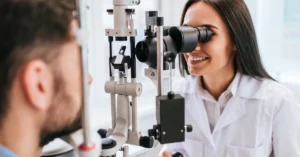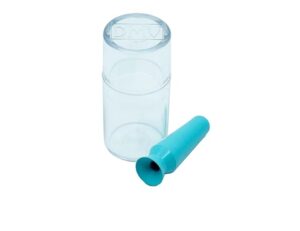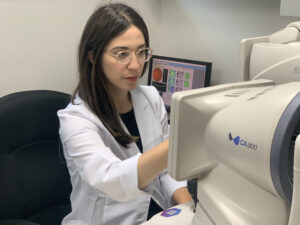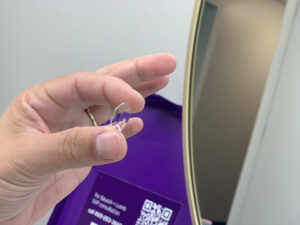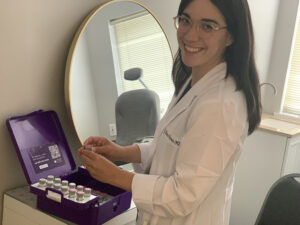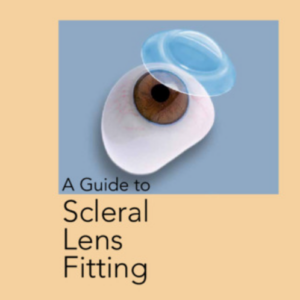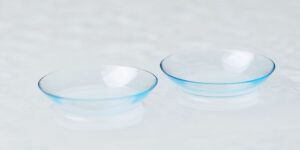Wearing Scleral Contact Lenses
Scleral lenses are a type of contact lens that are used to correct vision problems and treat certain eye conditions. They are larger in diameter than traditional contact lenses and are designed to rest on the sclera, or the white part of the eye, rather than on the cornea.
Scleral lenses are often used to treat severe cases of nearsightedness, farsightedness, and astigmatism that cannot be corrected with traditional contact lenses or glasses. They can also be used to treat certain eye conditions such as keratoconus, a condition in which the cornea becomes thin and cone-shaped, and dry eye syndrome, a condition that occurs when the eyes do not produce enough tears.
Scleral lenses are made from rigid, gas-permeable material that allows oxygen to reach the eye. They are custom-made to fit the specific shape and size of the wearer’s eye and are typically worn during the day. They may be removed at night for cleaning and disinfection.
Scleral lenses can be more comfortable to wear than traditional contact lenses because they do not rest directly on the cornea. They can also provide better vision and greater stability than traditional contact lenses because they do not move around on the eye as much. However, they can be more difficult to insert and remove than traditional contact lenses and may require more time and practice to get used to.
It is important to follow the instructions provided by your eye care provider for cleaning, disinfecting, and wearing scleral lenses to ensure proper care and prevent eye infections. It is also important to see your eye care provider regularly for follow-up visits to check the fit and health of the lenses and to make any necessary adjustments. If you have just been prescribed scleral lenses, here are seven things you can expect when you start wearing them.
1. Improved vision
One of the main reasons people choose to wear scleral lenses is to improve their vision. These lenses are designed to correct a variety of visual impairments, including myopia (nearsightedness), hyperopia (farsightedness), astigmatism, and presbyopia (age-related loss of near vision). They can also be used to treat conditions such as keratoconus (a progressive thinning of the cornea) and corneal scars. If you have struggled with poor vision due to one of these conditions, you can expect to see a significant improvement in your vision when you start wearing scleral lenses.
2. Increased comfort
Scleral lenses are known for being comfortable to wear, even for people who have struggled with discomfort or irritation from other types of contact lenses. This is because scleral lenses are larger than traditional contact lenses and cover a larger area of the eye, providing a more stable and comfortable fit. They are also made of materials that are designed to retain moisture and prevent dryness, which can be a common issue with other types of contact lenses.
3. A longer adaptation period
While scleral lenses can provide many benefits, it is important to note that they may require a longer adaptation period than traditional contact lenses. This is because scleral lenses are larger and sit on a different part of the eye, so it may take some time for your eyes to get used to the feel and movement of the lenses. This adaptation period can vary from person to person, but it is generally recommended to give yourself at least a few weeks to get used to the lenses before expecting to see the full benefits.
4. The need for proper lens care
Like any other type of contact lens, scleral lenses require proper care and maintenance in order to function effectively and maintain their longevity. This includes cleaning and disinfecting the lenses on a daily basis, using the correct solution, and handling the lenses with care. It is also important to follow your eye doctor’s instructions for lens insertion and removal, as improper handling can lead to damage or discomfort.
5. The need for regular check-ups
It is important to have regular check-ups with your eye doctor when wearing scleral lenses, as they can help to ensure that the lenses are fitting properly and that your eyes are healthy. Your eye doctor will check the fit of the lenses and make any necessary adjustments, as well as monitor the health of your eyes to ensure that you are not experiencing any problems or complications. These check-ups are typically scheduled on a monthly or quarterly basis, depending on your specific needs and the recommendations of your eye doctor.
6. The possibility of minor side effects
While scleral lenses are generally considered safe and effective, it is possible to experience minor side effects when wearing them. These may include dryness, redness, or irritation of the eyes, as well as blurry vision or discomfort when inserting or removing the lenses. In most cases, these side effects can be easily managed by following your eye doctor’s instructions for lens care and use. However, if you experience any significant discomfort or vision changes, it is important to contact your eye doctor right away.
7. The need for a backup pair of glasses
While scleral lenses can improve your vision and provide a comfortable fit, it is still important to have a backup pair of glasses on hand in case of emergencies. This is especially important if you rely on your scleral lenses for daily activities, such as driving or reading. Having a backup pair of glasses can help to ensure that you have a reliable backup plan in case something happens to your scleral lenses or you are unable to wear them for.

